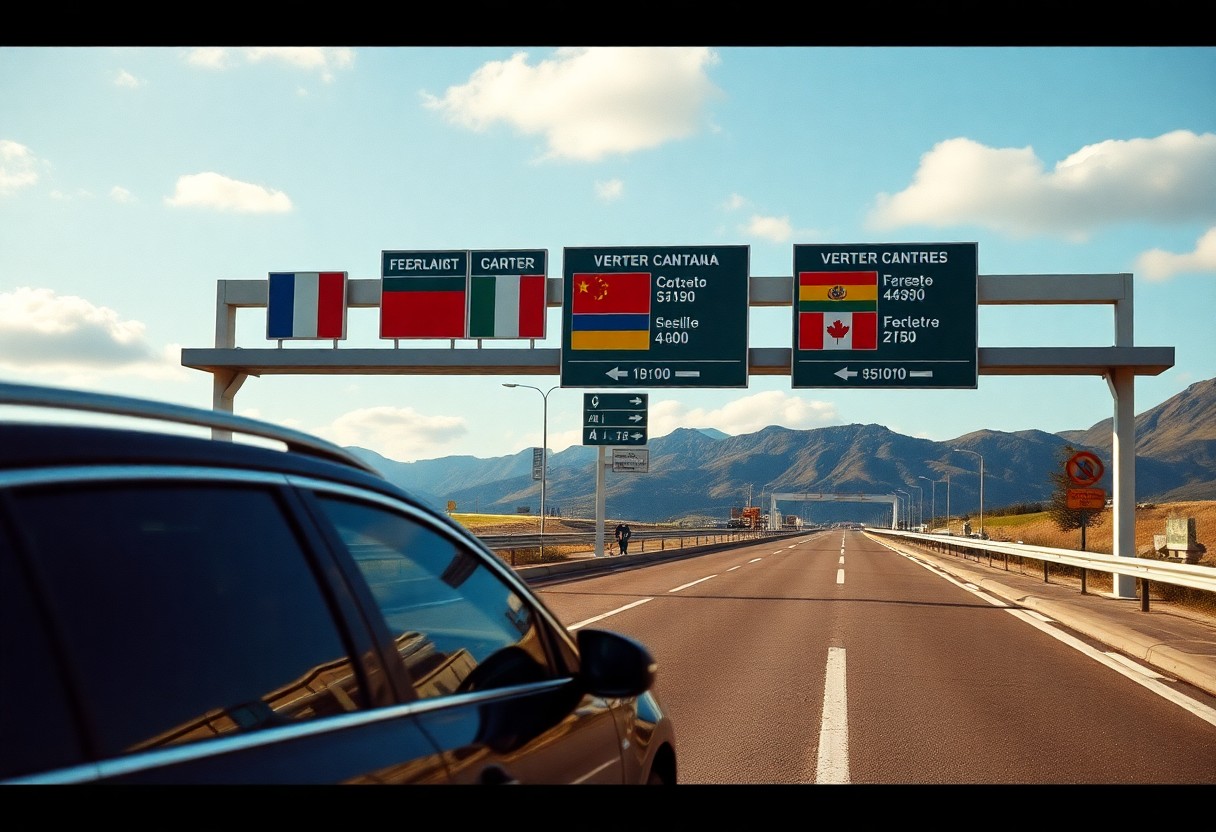Planning for overseas travel in Europe using a rental car is pivotal for ensuring a seamless and enjoyable journey. This preparation entails meticulous route planning and a comprehensive understanding of cross-border regulations. Each rental company has its own policies regarding driving between different European nations. While most companies generally permit travel within Western European countries, there are often restrictions when traveling to Eastern European nations. It is essential to carefully examine your rental agreement, as it will specify the borders you are authorized to cross and any potential additional fees that may apply. Before finalizing your booking, confirm that your selected rental company allows travel to all your intended destinations, as breaching cross-border regulations could void your insurance coverage and lead to hefty penalties. Thus, obtaining clear and detailed information about these restrictions is crucial for your European road trip.
Understand the Crucial Legal Requirements for Cross-Border Driving
Before setting out on your adventure across Europe with a rental car, fulfilling specific legal and rental company requirements is imperative. Ensure your rental agreement explicitly states that cross-border travel is permitted and that you have valid insurance coverage for all the countries you plan to visit. Many rental companies impose restrictions based on designated European zones, and these rules tend to be more stringent for luxury vehicles. Consequently, it is vital to familiarize yourself with these requirements to prevent complications during your travels and ensure a hassle-free experience.
Secure Your International Driving Permit (IDP) for European Travel
One of the most essential documents required for driving in Europe is an International Driving Permit (IDP). It’s advisable to obtain this permit before your travel plans commence in your home country. The IDP serves as a complement to your regular driver’s license and is legally mandated in numerous European countries. By securing your IDP well in advance, you ensure compliance with local regulations, facilitating a smoother driving experience across various nations and minimizing potential legal issues.
Be Aware of Mileage Policies and General Restrictions
When renting a car in Europe, numerous rental locations provide vehicles with unlimited mileage options, which is a significant advantage for travelers eager to explore. However, it’s important to recognize that border crossing fees may apply, typically ranging from €5 to €47.60 per crossing, depending on the rental company and the specific countries involved. Moreover, due to insurance and security protocols, rental companies often impose specific restrictions for different vehicle categories. High-end brands such as BMW, Mercedes, and Audi frequently have more limited travel zones compared to standard models, emphasizing the necessity to declare your travel plans in advance to avoid unexpected charges and ensure a smooth journey.

Gain Insights into Cross-Border Policies of Major Rental Companies
When renting a car in Europe, comprehending that each rental company has distinct cross-border policies is crucial. Major rental companies generally allow travel between Western European countries, but you will encounter strict restrictions for Eastern Europe. The policies can vary significantly depending on the type of vehicle, with luxury cars often facing more limitations compared to standard vehicles. By understanding these policies ahead of time, you can make informed decisions about your rental choices and travel plans, allowing for a more enjoyable experience.
Explore Cross-Border Regulations from Avis and Enterprise
Avis and Enterprise are two companies that provide extensive coverage across Western Europe. Their vehicles can typically be driven in most EU countries, including popular destinations like France, Germany, and Spain. However, it’s critical to note that both companies impose specific restrictions on luxury vehicles, particularly concerning travel to Italy. For instance, Enterprise charges a daily cross-border fee of 5 euros, with a maximum total charge of 50 euros. Familiarizing yourself with these fees will help you budget appropriately for your travels, ensuring you are financially prepared for any additional costs.
Understand Cross-Border Driving Policies of AutoEurope and Hertz
Among the prominent rental providers, AutoEurope and Hertz implement specific country restrictions that are vital for travelers to grasp. For example, taking their vehicles into Eastern European nations such as Albania, Belarus, or Ukraine is strictly prohibited. Additionally, Hertz restricts luxury vehicles and SUVs from entering Italy, while AutoEurope’s policies may vary based on their local partners. Therefore, it is essential to declare your travel intentions to your chosen provider before booking your rental car. Your rental agreement will detail the applicable cross-border fees, which differ by company and destination. For instance, Hertz charges 47.60 euros for crossing from Germany to another approved country, and you will likely need additional insurance coverage for international travel.
Geographical Restrictions You Must Keep in Mind
The regulations governing cross-border travel with rental cars in Europe can vary widely based on the rental company and the type of vehicle you select. Your rental agreement will clearly outline the countries you are allowed to visit with your rental car. Keeping your rental company informed about your planned route is essential, as crossing borders without proper permission can void your insurance and result in significant penalties, thus highlighting the importance of thorough planning.
Identify Countries You Are Allowed to Drive In
Most rental companies permit you to drive freely within Western European countries, including France, Germany, and Spain. Zone 1 countries typically encompass EU member states in Western Europe, offering the most flexibility for your rental car usage. Your rental agreement will specify all the permitted countries based on your vehicle class, ensuring you have a clear understanding of where you can travel and helping you avoid any potential issues during your journey.
Comprehend Restricted Territories for Travel
Countries behind the Iron Curtain are often subject to restrictions. Most rental companies prohibit travel to Eastern European countries, including Albania, Belarus, Ukraine, and Russia, due to increased risks and insurance complications. Moreover, additional limitations may apply to luxury vehicles and specific car brands. High-end vehicles like BMW, Mercedes, and other premium models often have stricter geographical limits. If your travel plans involve multiple countries, it is advisable to select a standard vehicle class to maximize flexibility and minimize potential fees or insurance complications and ensure a smoother travel experience.
Know Vehicle-Specific Limitations for Rental Cars
While rental companies may have varying policies, most enforce strict regulations regarding which vehicles can cross borders. Hence, it is essential to check the specific limitations associated with your chosen vehicle class before booking. These restrictions are designed to protect valuable assets and ensure compliance with insurance requirements across different European territories, safeguarding both the renter and the rental company.
Enjoy Flexibility with Standard Rental Cars
Contrary to common misconceptions, standard rental cars provide the greatest flexibility for cross-border travel. You can generally drive standard vehicles in most Western European countries without needing special permits. However, it’s important to inform your rental company about your travel intentions, as you may need to pay cross-border fees ranging from 5 to 50 euros depending on your specific situation. This proactive approach ensures a smoother travel experience.
Recognize Restrictions on Luxury Vehicles for Cross-Border Travel
Significant restrictions apply to high-end vehicles in terms of cross-border travel. Luxury cars face notable limitations on border crossings, with brands such as BMW, Mercedes, and Audi often prohibited from entering Eastern European countries or Italy. Generally, these luxury vehicles are confined to Zone 1 countries within Western Europe, necessitating careful consideration when planning your route.
Additionally, if you plan to rent luxury vehicles, expect higher security deposits and stricter insurance requirements. Rental companies like Sixt and Enterprise impose limitations on premium brands like Jaguar, Maserati, and Porsche, allowing them only in select Western European countries. For any border crossings, you will require special permission and potentially additional insurance coverage, ensuring you are adequately protected during your travels.
Plan Your Budget for Border Crossing Costs
It’s paramount to keep your budget in mind when organizing any cross-border trips in Europe with a rental car. Most rental companies impose additional fees for crossing borders, even within the Schengen Area. Informing your rental company of your intended route and obtaining written permission prior to crossing any borders is essential to avoid unexpected charges, helping you manage your travel expenses more effectively.
Review Typical Fees for Border Crossings
Border crossing fees in Europe typically range from €5 to €50, depending on the rental company and specific circumstances. For example, you’ll incur €47.60 with Hertz when crossing from Germany to another allowed country, while Enterprise charges €5 per day, capping at €50 for trips starting in Germany. Being aware of these fees will aid in your financial planning during your travels, ensuring you remain within your budget.
Consider Potential Additional Charges
At certain borders, you may face extra insurance requirements and documentation fees. Your rental company might charge for special permits, especially when traveling to Eastern European countries or when using luxury vehicles. Furthermore, you should consider the likelihood of higher insurance premiums for specific destinations, particularly in Italy or Eastern Europe. Remember that some credit card insurance policies may not cover all European countries, necessitating the purchase of additional coverage from your rental company for peace of mind during your journey.

Navigate the Nuances of Ferry Travel with Your Rental Car
Not all rental companies share the same policies regarding ferry travel in Europe. While most companies allow ferry travel, it’s vital to verify the specific rules associated with your rental. Crossing water borders often requires additional documentation and may incur extra fees that you need to be prepared for. Additionally, your insurance coverage might change when traveling by ferry, so understanding these aspects is crucial for a smooth travel experience.
Understand Company-Specific Ferry Policies
Among prominent rental companies, policies regarding ferry travel can differ considerably. Avis and Hertz typically allow ferry travel to approved countries, but it is essential to verify destination restrictions beforehand to avoid complications. In contrast, Enterprise and Sixt may require pre-authorization and additional insurance for ferry crossings, which must be clearly stated in your rental agreement to prevent any misunderstandings.
Important Considerations for Breakdown Coverage during Ferry Travel
Another critical factor to consider is vehicle breakdown coverage in the event of ferry travel. Most rental companies hold you accountable for vehicle repatriation costs if your car breaks down after a ferry crossing, which can amount to several thousand euros, depending on your location and the type of vehicle being rented. This responsibility extends beyond mechanical failures; if you have an accident or the vehicle becomes unusable for any reason while on an island, you are liable for the costs required to return the vehicle to the original rental location. Some rental companies do offer additional insurance to cover these expenses, but it is vital to purchase it prior to your journey to ensure you are adequately protected against such scenarios.
Essential Takeaways for Cross-Border Driving with Rental Cars
When planning to drive a rental car across European borders, thorough research and understanding of specific rules with your rental company are essential. You may have the freedom to cross borders in most European countries, but keep in mind that each rental company has its unique policies and fees that you need to be aware of. The type of rental vehicle you choose can significantly affect where you are allowed to travel, with luxury cars often facing more restrictions than standard models. Always confirm the countries you are allowed to visit, account for any required border crossing fees, and check the ferry travel regulations before embarking on your trip. Reading the rental agreement closely and obtaining an International Driving Permit will further prepare you for a smooth journey. Your advance planning is key to avoiding complications at border crossings, ensuring a more enjoyable travel experience.
Frequently Asked Questions About Driving Rental Cars in Europe
Can I drive my rental car to any European country without restrictions?
No, rental companies maintain specific regulations regarding the countries you can visit. Most companies permit travel within Western European nations such as France, Germany, and Spain. However, many impose restrictions on travel to Eastern European countries, including Albania, Belarus, and Ukraine. Luxury vehicles often have more stringent limitations. Always check your rental agreement for allowed countries prior to any border crossings to avoid any issues.
Will I incur additional fees for crossing borders with a rental car in Europe?
Yes, many rental companies impose border crossing fees. For example, Hertz charges 47.60 euros for each border crossing from Germany, while Enterprise charges 5 euros per day (with a maximum of 50 euros) for trips originating in Germany. These fees apply even when traveling within the Schengen Area. It is crucial to inform the rental company about your travel itinerary and settle these fees before crossing any borders to avoid unexpected costs.
Can I take my rental car on a ferry between European countries?
Yes, most rental companies allow ferry travel if your destination country is included on their approved list. However, if your vehicle breaks down while on an island, you will be responsible for the costs associated with returning the vehicle to its original rental location. Some companies, such as Hertz, offer coverage for ferry travel through their insurance options (CDW, TP, or SuperCover). Always verify the specific ferry policies stated in your rental agreement to avoid any surprises during your journey.
The Article: Is It Allowed to Drive a Rental Car Across European Borders? appeared first on https://rentacar24.org/
The Article Driving a Rental Car Across European Borders: Is It Allowed? Was Found On https://limitsofstrategy.com



You make a great point about the importance of checking rental car policies! I recently planned a trip to Europe and it was a bit of a headache trying to figure out which countries I could drive to without racking up extra fees or voiding my insurance. I ended up sticking to Western Europe because of the restrictions I found. It’s wild how each company has different rules.
I can definitely relate to that stress of navigating rental car policies. It seems like every company has its own set of rules that can vary so much even between neighboring countries. It’s a bit of a maze trying to piece everything together just to have a smooth trip. When I planned a road trip in Europe a couple of years back, I found myself in a similar situation, trying to decipher which countries were off-limits or if I could use my insurance when crossing borders.
I can totally understand where you’re coming from—it can be such a hassle trying to navigate those policies. When I went on a road trip through Europe, I remember feeling overwhelmed by all the fine print and restrictions. It’s frustrating how different regulations can be just across a border; it often feels like they’re designed to trip you up rather than help make travel easier.
I totally get that feeling. It’s like every country has its own little rulebook, and trying to piece it all together can be a real headache. I had a similar experience when I rented a car in Italy—one minute, you’re cruising through vineyards, and the next, you’re stressed about ZTL zones and which roads to avoid.
Navigating rental car policies can really feel like diving into a puzzle, especially when considering various countries involved. I’m with you on the challenges of figuring out what’s allowed and what isn’t, particularly when you have plans to cross borders. It’s surprising how many people don’t realize that what works in one country can vary drastically just across the border.
Navigating the ins and outs of rental car policies can feel like solving a puzzle, especially when you’re trying to piece everything together across different countries. You’re not alone in that experience; many travelers have stumbled through similar situations. I remember planning my own travels and feeling a bit overwhelmed by the myriad rules and regulations—like trying to decipher a secret code.
You’re definitely not alone in feeling that way about rental car policies—they can really be a bit of a minefield. I experienced something similar during a trip to Spain last year. I wanted to explore a bit beyond the major cities, especially the smaller towns that often don’t get as much attention in guidebooks. But trying to navigate all the different insurance stipulations and country restrictions was more complicated than I expected.
You’ve touched on such an important aspect of travel that often gets overlooked until it’s too late. I fondly remember my own road trip through Europe a few years back, and being meticulous about cross-border regulations saved me from a world of stress.